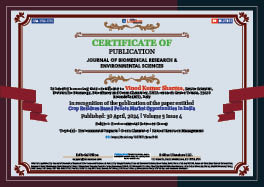Sunil Dhingra and Vinod Kumar Sharma*
Volume5-Issue4
Dates: Received: 2024-03-13 | Accepted: 2024-04-24 | Published: 2024-04-30
Pages: 403-410
Abstract
Ever increasing use of fossil fuels such as coal and oil, contributing significantly to global warming and a great deal of harm to the environment. It is of utmost necessity to develop green sources of energy not only to generate power but most importantly to reduce the impact of energy production on the environment. In addition to the climate challenges, we are now facing challenges related to high energy prices and the high risk of supply shortages. Energy and, in particular, the clean energy is an important topic that needs special attention by the scientific community World-wide and, more so, in the context of the developing countries. Renewable energy should be looked as the most important instrument for the socioeconomic development, eradication of poverty and unemployment and an instrument of rural development.
Amongst potential renewable energy sources, biomass can play an important role in achieving a net-zero carbon emissions and can be used to produce electricity, transportation fuels, or chemicals. Development of small to medium size technologies for power production in order to allow the exploitation of low value feedstocks, such as biomass residues from forest management, agro-industrial, agricultural sectors and wood industries, are of importance, especially in the context of the developing country, like India.
It is in the above context that to address many challenges, such like biomass collection, processing, storage and its transportation to the point of ultimate utilization an important idea to develop decentralized model involving Farmer Producer Organizations (FPOs), farmers cooperatives, etc. in production of crop residue pellets or terrified pellets at village level, has been discussed in the present paper.
FullText HTML
FullText PDF
DOI: 10.37871/jbres1906
Certificate of Publication

Copyright
© 2024 Dhingra S, et al. Distributed under Creative Commons CC-BY 4.0
How to cite this article
Dhingra S, Sharma VK. Crop Residues Based Pellets Market Opportunities in India. J Biomed Res Environ Sci. 2024 Apr 30; 5(4): 403-410. doi: 10.37871/jbres1906, Article ID: JBRES1906, Available at: https://www.jelsciences.com/articles/jbres1906.pdf
Subject area(s)
References
- Central electricity authority- Dashboard. 2023.
- Monitoring paddy residue burning in India using satellite remote sensing during. 2023.
- MNRE report, evaluation study for assessment of biomass power and bagasse cogeneration potential in India. Final Report. 2021
- Samarth biomass mission. 2024.
- Guidelines for grant of one-time financial support under Environment Protection Charge (EPC) Funds for establishment of palletisation & torrefaction plants to promote utilization of paddy straw. CPCB.
- MNRE biomass programme (Scheme to Support Manufacturing of Briquettes & Pellets) under the umbrella scheme of national bioenergy programme for duration of FY 2021-22 to 2025-26.
- Benchmarking of price in NCR Region. Doc: F. No. LLt8,6/zOt7'Th.II (C.No 23A797), Ministry of Power, Govt of India.
- Benchmarking of pellet price in northern region (except NCR). Doc: F. No. LL / 86 / 2Or7 -Th.II (C.No 238797), Ministry of Power, Govt of India.
- Benchmarking of price in Western region. Doc: F. No. LL / 86 / 2ot7 -Th.II (C.No 238797), Ministry of Power, Govt of India.






























































